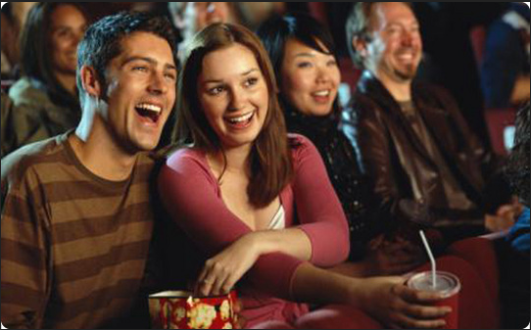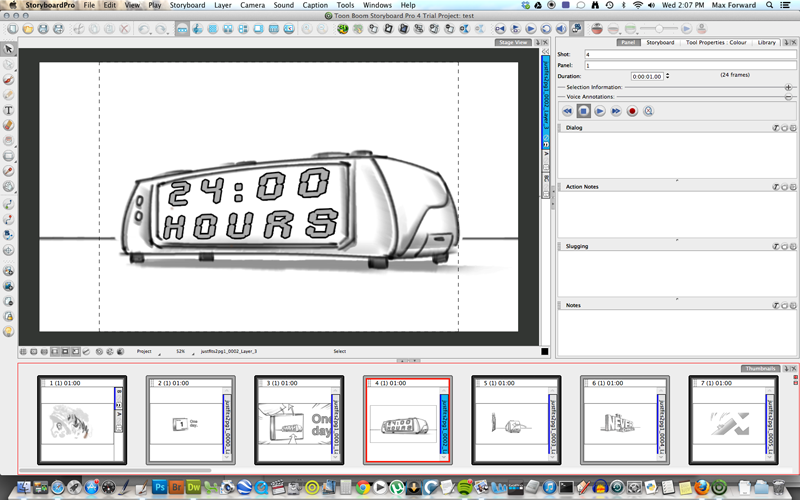I was working onsite yesterday and got an email notification from Toon Boom announcing their new update to the successful and highly-lauded application, Storyboard Pro, now in version 4. The email touts the many new features, the most significant of which are the new “bitmap drawing” tools. You might be thinking “Don’t most drawing programs use or at least offer bitmap drawing capabilities anyway? Bit maps are just pixels, right?” You’d be right to assume that, and this feature is long overdue.
I’ll take a second, if you are not familiar, to introduce Storyboard Pro- to my knowledge the only serious program to attempt to tackle the unique challenges of storyboarding. Other applications exist, most are free, and most are rather hideous-looking and offer no drawing tools. Almost none are available for OS X. So Storyboard Pro is basically the only player in this game, currently.
It’s main features include very basic drawing tools (I don’t think I’m being unfair to compare their early offerings to something visually akin to MS Paint), fairly robust formatting options, and a fairly flexible user interface. The program really does a good job of meeting the needs of a highly complex and infinitely variable and rapidly evolving approach to animation production, and I’m sure it works as advertised in terms of syncing with the other Toon Boom offerings like Animate or Flip Book or whatever.
But I don’t regularly use Storyboard Pro, and doubt I will start anytime soon, because it rarely brings any utility to the field of commercial storyboarding, and it really comes down to the program’s inability to truly fine tune the page presentation layout and sequencing options, even though, as mentioned above, the program does attempt to offer a wide range of options. But it doesn’t go far enough, not nearly far enough.
One of the biggest challenges in storyboarding is, believe it or not, arranging the finished panels, or frames, onto a page. I call this layout process “sequencing,” and believe me, it can be a real headache. It seems simple, until you actually try it. I’ll explain.
To start with, check this out. Just do a google image search for “storyboards,” and take a moment to see all the billions of ways people storyboard. Some people like to arrange their panels vertically, some horizontally, some have 3 across, some have 6 down, some like 8 to a page, 9 to a page, 12 to a page, 24 to a page etc etc. Each artist has their own preferred way of working. Every studio, even major studios, have subtle and sometimes drastic differences in the ways they want their storyboards sequenced. So here’s the troubling conclusion: There is no codified, generalized, accepted, time-tested, traditional, normal way to storyboard. There is no standard to speak of. As by means of contrast, I invite you also to look at the google image searches for “screenplay” and “sheet music,” to see for yourself the relatively harmony and unity of those layout structures. Not nearly the kind of variation you see in storyboarding.
The wild differences in layout styles between production houses cause huge problems for freelance storyboard artists in the commercial realm. I have many clients, and each wants their boards to look have the “signature” layout of the studio, and each believes their method is best (it isn’t) or more in keeping with “the standard” (there isn’t one). This is usually part of their strategy of getting an edge on the competition, due to the competitive bidding nature of the industry. The advertising agencies award jobs based in part on the presentations of my clients, and storyboards are a big part of that. So, whatever they can do to make those storyboards look more special, must be done. I understand the motivation, and so I do my best to accommodate.
This brings me to the underlying reason that sequencing is such a pain- REVISIONS. Happens all the time, almost every time. Careful consideration, from start to finish, is given to the each frame and it’s place in the presentation… the drawing portion is finished, and now I lay them out in sequential order: frame 1, 2, 3, 4 etc, page after page, sometimes 15 pages worth, as has been typical of my more extreme cases. Usually this is done in Photoshop, due to it’s stability and high performance text tools. Text very often accompanies storyboard drawings and sometimes many short paragraphs of text will accompany each drawing. I export jpgs of each page, usually 4 to a page, in vertical format, and then compile those pages into a pdf, and present that to the director for final approval. He/she mulls it over and says “Looks really great, Max. Fantastic. Oops! I forgot that we need one additional frame.” Nuclear bombs explode in my head. “I need to add just ONE frame in very beginning,” they continue, “that’s not so bad is it?” They smile insidiously, knowing FULL WELL that their simple, reasonable request, will take an hour to implement. Why?
Simply put, because injecting an additional frame at the beginning of a storyboard means that all of the subsequent frames must be nudged over 1 space. That’s not far to go, but imagine this analogy: You arrive at a movie theater, and you and your wife wish to sit at the start of a particular row, but only one seat is available on that end. On the far end, another seat is available. If everyone would simply shift one seat over, you could all fit in the row and you could sit with your wife. “Hey everybody, would you, please, one at a time, starting with you there, on the far end, please grab you popcorn, candy, and snacks, and move over 1 seat to the right?” Everybody GROANS! What a pain in the ass. Re-sequencing is no fun! It’s really the only part of my job that I don’t enjoy.
Now, this is a scenario where Toon Boom Storyboard Pro really can help. It can automatically sequence on the fly. Like everyone in the theater could stay in their seats, and the seats moved over slightly (like on a conveyor belt) and a new extra seat popped up for your wife exactly where you wanted. And, if you wanted to change your mind and sit somewhere else, you can do that, on the fly. Nice!
But TBSP can’t offer you any sequencing help if you can’t find an export option that’s compatible with what your client likes to see in their layout. TBSP has lots of export options, I give them good credit for really attempting flexibility, but they continue to fall short when it comes to the specific information that accompanies each storyboard panel. TBSP insists on including information that is irrelevant to my clients, and is often ugly and cluttering, such as panel number out of total number of panels, displayed in such offerings as “(004/026),” or “004 | 1/1″when all I want is a “4.” A simple “4.” Toon Boom Storyboard Pro can’t do it.
Say I want to add a bit of dialogue to a panel. TBSP unhelpfully insists that the word “Dialogue:” be included as part of the caption. I don’t have a lot of room under these panels to write out text, and “Dialogue” is too long a word, and frankly, clutters up the design of the storyboard page.
It’s tiny, irrelevant, unadjustable inclusions like these that prevent me from regularly using this software. When I do use it, it’s for the longer form projects, where the directors are notorious for last-minute frame additions, and they are willing to forego a sense of style to their storyboards. That’s it.
So now there’s a new version of Toon Boom Storyboard Pro. TBSP 4 is available for purchase and I tried out the trial version of it this morning. I could tell that overall this version was running faster and more streamlined than my earlier version (1.5). Much has been done to simplify and streamline the interface and I appreciate the new bitmap drawing tools very much. The program feels fast. Maybe that’s because the 30-frame limit is keeping the program from drawing on too many of my computer’s resources, but I can’t substantiate that one way or another. It’s definitely an improvement. I feel like I could adapt to this if I needed too. But I doubt my clients could, because, even though I could tell they have made efforts to evolve their export/layout options to have more flexibility, it’s still way off the mark. If TBSP can’t match the existing appearance of a client’s storyboard template, I can’t use it.
Also, it’s $999, which smacks to me of a 1-day-late April Fool’s joke. I would pay $200 for it, tops.
Just my two cents. Thanks for reading!





7 responses to “Toon Boom Storyboard Pro 4 is here! Yay?”
I’m glad I’m not the only one that thinks the price is a bit nuts.
I’m kind of glad for the high price, because I wasn’t going to buy it anyway, and now it stokes demand for a cheaper alternative, which I might buy. Shotbox is out of beta, and now a subscription-driven model at $9.99/month, which I find somewhat frustrating, as it would definitely fit many business models, but not my own field of commercial storyboarding, since most of my projects only last 2-3 days and don’t require me to formally layout my boards in sequence or animatic (many cut their own animatics in FCP or Premiere, after I supply them with individual frames). As such, I can’t justify the price because I would only use it once or twice a month and probably never again for the same project. But as I said before, there are many production pipelines that could work with this pricing schedule. I feel it’s more geared toward producers than storyboard artists themselves, since they would be the ones with a vested stake in having creative control of a storyboard from month to month.
If any new alternatives come to my attention, I’ll blog about them.
it stokes demand for a crack..
MUHAHAHAHA
No serious..
is there a big change this will be cracked?
I hope it soooo much
Well, it probably already has been. But I don’t use pirated software.
I’m a professional storyboard artist and I’ve been using SBP for years. I had a lot of problems with 1.5, almost to the point that I didn’t want to use it. But v4 took care of almost all those qualms. Export options have never been a problem for me (or my clients) though, even in v1.5. There are a lot of template options, plus you can customize your own layout. Plus you can always just export JPEGs of each panel and compose them onto pages in another application like Photoshop, if you really need to. I have very minor issues with v4, but over all it has been amazing (and from what I read I think v4.1 might address some or all of my minor issues with v4). I can’t imagine not using it now for my jobs, so for me the price tag was well worth it. From reading your article, especially the “$200 tops” comment, it seems like you don’t really know the capabilities of the program. It is very deep. $200 for such a powerful and niche application is absurd.
Hi Anonymous, I’ll stick by my original quasi-review, despite it being ancient history by now and I’ll concede that it’s possible the newer versions of program might address my earlier stated concerns. I’ll also reiterate, it does appear that Storyboard Pro is the best Storyboarding application that’s out there. What’s it up against? Well, not much. A quick google search turns up practically no alternatives.
Luckily I haven’t had to use storyboard pro at all since I wrote that review. I basically use Painter 12 and Adobe Photoshop CS5 to draw my frames, and I’ll export my frames individually, just deliver them as a batch of numbered jpgs in a folder. Most of my clients have transitioned the role of laying out storyboard presentations to their staff Junior Designers, Producers, and sometimes the Directors themselves. This is possible because of the relatively low number of storyboards needed for a commercial.
Anyway, Anonymous, I’m sure anybody reading along is curious to know more about what kinds of storyboards you draw and why SBP works for you, and so I invite you to post any links to boards or other information you like in this comment thread.